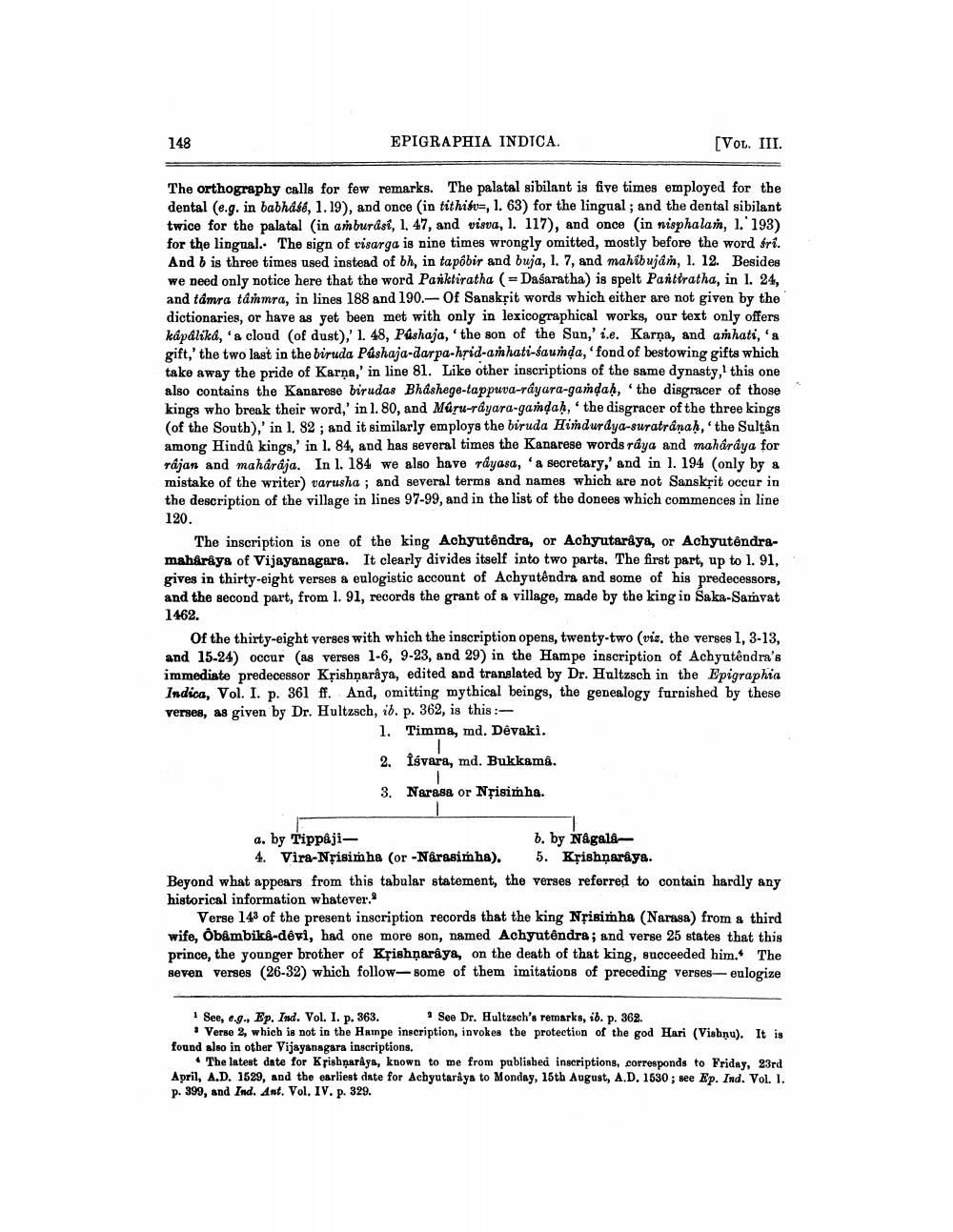________________
148
EPIGRAPHIA INDICA.
(VOL. III.
The orthography calls for few remarks. The palatal sibilant is five times employed for the dental (e.g. in babhase, 1.19), and once in tithifv=, 1. 63) for the lingual; and the dental sibilant twice for the palatal (in anburdsi, 1. 47, and visva, 1. 117), and once (in misphalan. 1. 193) for the lingual. The sign of visarga is nine times wrongly omitted, mostly before the word fri. And b is three times used instead of bh, in tapôbir and buja, 1. 7, and manibujan, 1. 12. Besides we need only notice here that the word Parktiratha (= Dasaratha) is spelt Pantiratha, in l. 24, and támra táimra, in lines 188 and 190.- Of Sanskrit words which either are not given by the dictionaries, or have as yet been met with only in lexicographical works, our text only offers kápálika, 'a cloud (of dust),' 1. 48, Püshaja, the son of the Sun,' i.e. Karņa, and amhati, a gift,' the two last in the biruda Pashaja-darpa-hșid-amhati-saumda,'fond of bestowing gifts which take away the pride of Karna,' in line 81. Like other inscriptions of the same dynasty, this one also contains the Kanarese birudas Bhashege-tappuva-rayara-gandah, the disgracer of those kings who break their word,' in l. 80, and Múru-rayara-gandaḥ, 'the disgracer of the three kings (of the South),' in l. 82 ; and it similarly employs the biruda Hindurdya-suratranaḥ, 'the Sultan among Hindû kings,' in l. 84, and has several times the Kanarese words raya and maharaya for rájan and maharaja. In 1. 184 we also have rayasa, a secretary,' and in 1. 194 (only by & mistake of the writer) varusha ; and several terms and names which are not Sanskrit occur in the description of the village in lines 97-99, and in the list of the donees which commences in line
120.
The inscription is one of the king Achyutêndra, or Achyutaraya, or Achyutêndramahirkya of Vijayanagara. It clearly divides itself into two parts. The first part, up to 1. 91, gives in thirty-eight verses & eulogistic account of Achyutêndra and some of his predecessors, and the second part, from 1. 91, records the grant of a village, made by the king in Saka-Samvat 1462.
of the thirty-eight verges with which the inscription opens, twenty-two (vie, the verses 1. 3-13. and 15-24) occur (as verses 1-6, 9-23, and 29) in the Hampe inscription of Achyutêndra's immediate predecessor Kộishnaraya, edited and translated by Dr. Hultzsch in the Epigraphia Indica, Vol. I. p. 361 ff. And, omitting mythical beings, the genealogy furnished by these verses, as given by Dr. Hultzsch, ib. p. 362, is this :
1. Timma, md. Dêvaki. 2. Îśvara, md. Bukkama.
3. Narasa or Nrisimha.
a. by T'ippaji
b. by Nâgala4. Vira-Nrisimha (or - Narasimha). 5. Krishnaraya. Beyond what appears from this tabular statement, the verses referred to contain hardly any historical information whatever.
Verse 143 of the present inscription records that the king Nrisimha (Narasa) from a third wife, Obambikk-dévi, had one more son, named Achyutêndra; and verse 25 states that this prince, the younger brother of Krishộarâye, on the death of that king, succeeded him. The seven verses (26-32) which follow-some of them imitations of preceding verses- eulogize
See, e.g.. Ep. Ind. Vol. 1. p. 363.
See Dr. Hultzach's remarks, ib. p. 362. • Verso 2, which is not in the Hampe inscription, invokes the protection of the god Hari (Vishnu). It is found also in other Vijayanagara inscriptions,
The latest date for Krishnaraya, known to me from published inscriptions, corresponds to Friday, 23rd April, A.D. 1529, and the earliest date for Achyutariya to Monday, 15th August, A.D. 1530; see Ep. Ind. Vol. 1. p. 399, and Ind. Ant. Vol. IV. p. 329.




